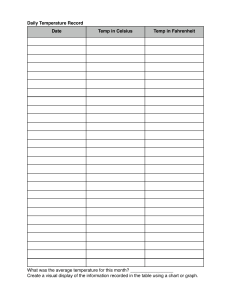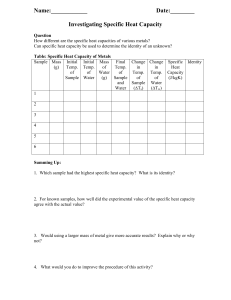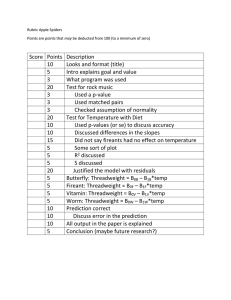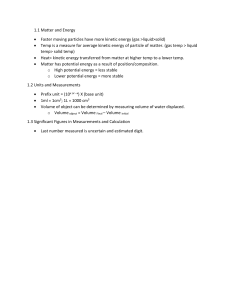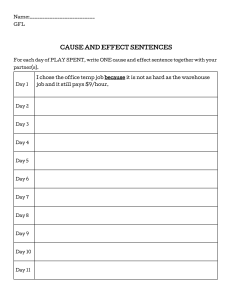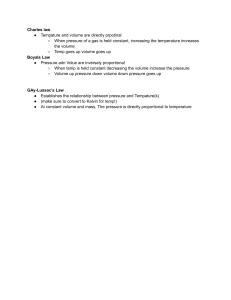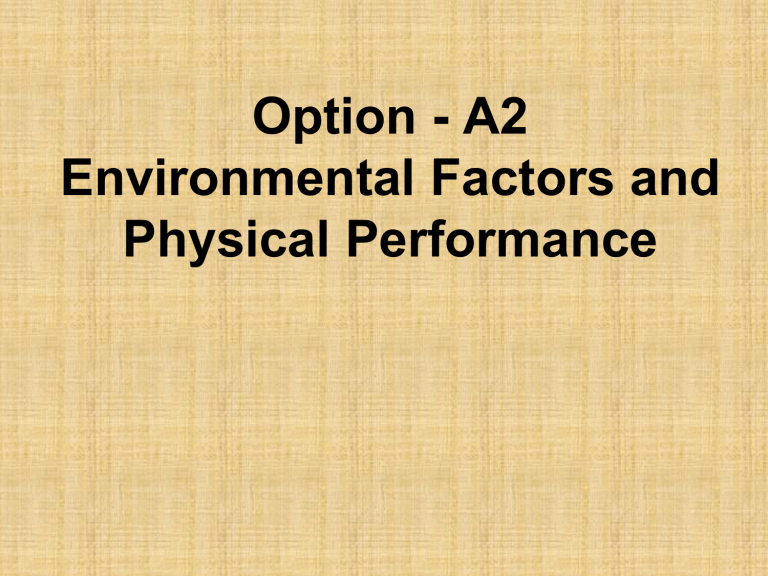
Option - A2 Environmental Factors and Physical Performance I. Cellular Metabolism and Heat Production *using and re-synthesizing ATP produces heat. *60-70% of energy produced is lost as heat. In other words, the energy released during cellular respiration is used to produce ATP. However, only a fraction of the released energy goes into making ATP. Overall the reaction is exergonic. (releases energy) II. Thermoregulation : the human body works to maintain an average core temperature. 37°C + .6° (98.6°F) Normal core body Resting adult 98.6 °F (37°C) Core temperature variation Metabolism Faster metabolism = higher temp. Time of day More active times = increase temp. Part of body used to measure temperature rectal – most accurate, slightly higher (99.6 °F or 37.6 °C) oral – easiest, used for normal range axillary - inaccurate (97.6 °F or 36.4 °C) ear – tympanic membrane temp. run higher than normal Balancing heat in the human body Heat loss from the body 1. Radiation: the transfer of energy waves between two objects of different temps. Example: Atmosphere temperatures 2. Convection: the transfer of heat from one place to another by the motion air or water. *cool wind blowing over the skin. *warm blood circulating through the body *water in a pool/ocean Temperature change is always from hot to cold. 3. Conduction: the transfer of heat energy between two objects in direct contact. Examples ice packs, snow, wet clothing, cold water. hot road, warm water, electric blanket. 4. Evaporation: the majority of heat lost during exercise is through the evaporation of sweat. This process takes energy which results in cooling. As sweat evaporates from the skin, a cooling effect is achieved thus releasing heat from the body. Which mechanisms for heat loss are used more often by our bodies at rest? During exercise? • How do we thermoregulate our bodies? 8 minutes III. Hot/Humid Environments: reduce the temp. gradient between the skin and the outside environ. Humidity reduces the amount of evaporation from the skin. A. When the outside temp. approaches body temp. the body responds by: *sweating *increasing respiration *altering the rate and depth of blood circulation 1. The Sweat Response *thermal receptors in the skin sense temp. change *the hypothalamus is the regulatory center. *signals from the hypothalamus cause vasodilation and trigger sweat glands to decrease core temp. 2. Heat Effects on the Circulatory System *excessive water loss increases blood viscosity. *blood flow to the muscles decreases, increasing glycogen use. *blood flow increases to the external surface of the skin. *decreased stroke vol. and increased heart rate B. Health Risks Assoc. with Exercising in the Heat 1. Heat Cramps: cramping, mostly in the legs, caused by salt imbalances. 2. Heat Syncope: feeling faint, dizzy from heat. 3. Heat Exhaustion: excessive water and salt loss causing headaches and dizziness. 4. Heat Stroke: body temp. rises to 105 causing lethargy, confusion and unconsciousness C. Prevention of Heat Related Disorders 1. Acclimatization: training in similar environmental conditions 5-10 days while initially reducing training intensity. *increases blood vol., sweat response and reduces the rate of muscle glycogen use. Prevention and Treatment of Heat Related Disorders 2. Proper hydration before training/event. 3. Educate yourself of the symptoms. D. Treatment of Heat Related Disorders 1. Move to cool environment. 2. Rehydrate 3. Place ice packs on the neck, groin and underarms 4. Loosen/remove clothing IV. Thermoregulation in Cold Environments A. Physiological Responses 1. Shivering: when muscles around the vital organs shake in an attempt to create warmth by expending energy. 2. Non-shivering thermogenesis: a rise in metabolism that is not related to muscular activities. *greater oxygen consumption metabolizes fats to generate heat. *common in infants due to more brown fat in the body. (packed with mitochondria) 3. Peripheral Vasocontriction: blood vessels in the skin constrict to divert blood to the core. B. Body surface area-to-body mass ratio: smaller people and children have a larger ratio and lose heat and fluids at a faster rate. C. Wind chill: the felt air temp. on exposed skin due to the convective cooling process of the wind. D. Heat loss in Swimming: swimming increases convective heat loss resulting in: *the cooling of nerve and muscle fibers *swimming and breath coordination become difficult E. Health Risks of Exercising in the Cold 1. Hypothermia: when the core temp. drops below the required temp., 350, for basic metabolism. *fatigue *confusion and irrational thinking *poor coordination and balance 2. Frostbite: Ice crystal formation in the tissues of exposed skin to extreme cold temps. F. Precautionary Measures for Exercising in the Cold *dress in layers to insulate the body. .6 cm of clothing adds 1 (clo) of insulation. *Keep clothing from getting wet *cover the head, neck and hands Non-Nutritional Ergogenic Aids in Sport A. The following ergogenic aids are banned by the International Olympic Committee (IOC) and the World Anti-Doping Agency (WADA) *anabolic steroids *hormones (EPO) *diuretics and masking agents *beta blockers *stimulants 1. Anabolic Steroids: substances that mimic the effects of testosterone. The increase protein synthesis resulting in the build-up of muscle. Negative Effects *high cholesterol *acne *high blood pressure *liver damage *testicular atrophy *gynecomastia *aggressive behavior http://www.youtube.com/watch?v=qfxoqje1 X7o&feature=youtu.be 2. Erythropoietin: (EPO) is a hormone produced naturally in the kidney that stimulates RBC development in bone marrow. *instead of blood doping endurance athletes are shooting EPO. Negative Effects *increased blood viscosity *blood clots (stroke/heart attack) *sudden death during sleep http://www.youtube.com/watch?v=t6OP h_a11QA 5 min 3. Diuretics and Masking Agents: are used to increase water loss and conceal the banned substance in the urine. Negative Effects *dehydration *cramping *loss of electrolytes *drop in blood pressure http://www.youtube.com/watch?v=H4Ua9q_0Os8 3 ½ minutes 4. Beta-Blockers: medications used to block the effects of adrenaline. They reduce heart rate, blood pressure, muscle tremors and anxiety. Negative Effects *severe blood sugar changes *heart failure *weight gain *extreme fatigue Kim Jong Su http://www.youtube.com/watch?v=WUuY3paZWs 3 min 5. Stimulants: any substance that increases alertness and physical performance. Ex. Caffeine, cocaine and amphetamines. Negative Effects *irregular heart beat *sleeplessness *dizziness *anxiety Note: a caffeine level of 12 mg/L of urine is acceptable by the IOC. http://www.youtube.com/watch?v=VvKQ2kVBwTU&list=PLxlVzd1n0m3tncpcYf u29_MCCJGCkC5vL 53 min
